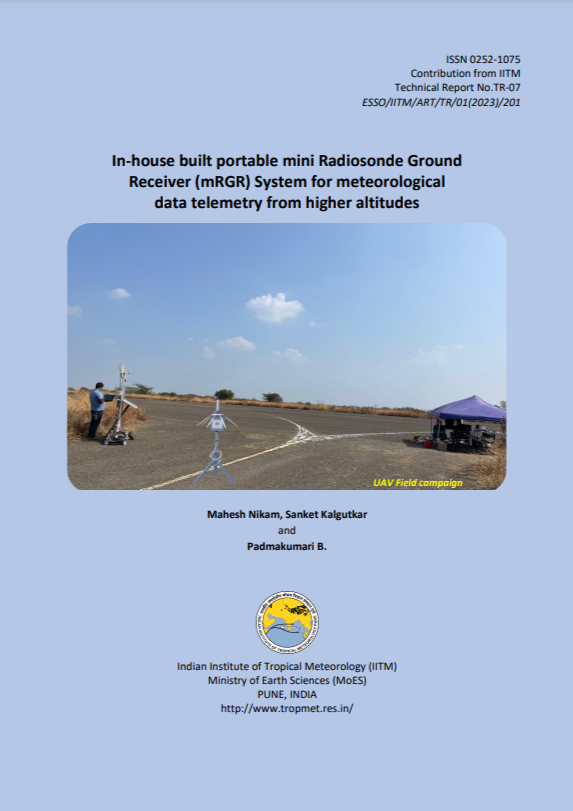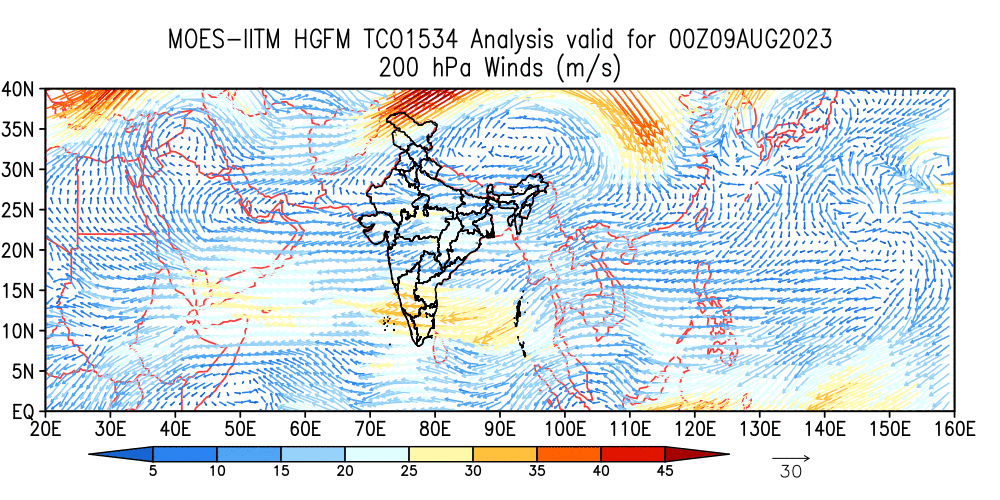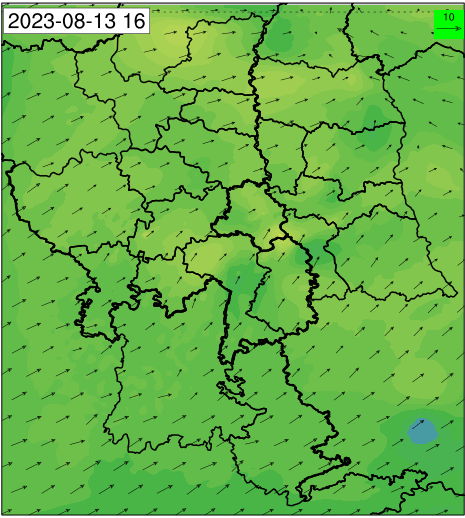Seminars / Lectures
RAC Poster Session
IITM Publication Highlights
Regional and temporal variability of Indian summer monsoon rainfall in relation to El Niño southern oscillation
 In this study, authors have shown that the ENSO-monsoon relationship is different across regions over India and has varied over timeframes during the last century. The study reports a significant change in this regional ENSO–monsoon relationship over the north, central, and south India. While the ENSO–monsoon relationship has stayed moderately strong and stable for south India, it has become exceptionally stronger over time for north India, while it has considerably weakened and become non-existent over the central Indian region in the recent decades.
The mechanisms and associated variability with respect to climate modes are discussed in the study.
In this study, authors have shown that the ENSO-monsoon relationship is different across regions over India and has varied over timeframes during the last century. The study reports a significant change in this regional ENSO–monsoon relationship over the north, central, and south India. While the ENSO–monsoon relationship has stayed moderately strong and stable for south India, it has become exceptionally stronger over time for north India, while it has considerably weakened and become non-existent over the central Indian region in the recent decades.
The mechanisms and associated variability with respect to climate modes are discussed in the study.
Athira K.S., Roxy M.K., Dasgupta P., Saranya J.S., Singh Vineet K., Attada R., Scientific Reports, 13: 12643, August 2023, DOI:10.1038/s41598-023-38730-5, 1-13
Read MoreImpact of nylon and teflon filter media on the sampling of inorganic aerosols over a high altitude site
 Water-soluble inorganic aerosols constitute major fraction of PM2.5 play an important role in the Earth-climate system and affect adversely on human health. Their measurement accuracy highly vary depending on choice of filter media and denuder usage. In most of the cases, denuders are either not deployed or their use is partially limited to removal of certain gases. To understand the impact of undenuded ambient sampling and filter media type on depositional loading of water-soluble inorganic aerosols; three (1 teflon and 2 nylon based) different pore-sized filter media sampling was carried at a high altitude location in Western Ghats during winter season. The study results show gas-phase adsorption was higher on nylon than hydrophobic teflon membrane. Decreased pH and overall increased conductivity observed on nylon media suggested higher adsorption of acidic species.
Water-soluble inorganic aerosols constitute major fraction of PM2.5 play an important role in the Earth-climate system and affect adversely on human health. Their measurement accuracy highly vary depending on choice of filter media and denuder usage. In most of the cases, denuders are either not deployed or their use is partially limited to removal of certain gases. To understand the impact of undenuded ambient sampling and filter media type on depositional loading of water-soluble inorganic aerosols; three (1 teflon and 2 nylon based) different pore-sized filter media sampling was carried at a high altitude location in Western Ghats during winter season. The study results show gas-phase adsorption was higher on nylon than hydrophobic teflon membrane. Decreased pH and overall increased conductivity observed on nylon media suggested higher adsorption of acidic species.
Yang L., Soyam P.S., Patil R.P., Ray A., Waghmare V.V., Haswani D., Raman R.S., Safai P.D., Pandithurai G., Environmental Advances, 12: 100373, July 2023, DOI:10.1016/j.envadv.2023.100373, 1-13
Read MoreStubble-burning activities in north-western India in 2021: Contribution to air pollution in Delhi
 Stubble-burning in northern India is an important source of atmospheric particulate matter (PM) and trace gases, which significantly impact local and regional climate, in addition to causing severe health risks. The study analyzes the satellite-retrieved stubble-burning activities in the year 2021, using the MODIS active fire count data for Punjab and Haryana, and assesses the contribution of CO and PM2.5 from such biomass-burning activities to the pollution load in Delhi. The analysis suggests that the satellite-retrieved fire counts in Punjab and Haryana were the highest among the last five years (2016–2021). The contribution from stubble burning activities to the air quality in Delhi is maximum (minimum) during the turbulent hours of late morning to afternoon (calmer hours of evening to early morning). The quantification of this contribution is critical from the crop-residue and air-quality management perspective for policymakers in the source and the receptors regions, respectively.
Stubble-burning in northern India is an important source of atmospheric particulate matter (PM) and trace gases, which significantly impact local and regional climate, in addition to causing severe health risks. The study analyzes the satellite-retrieved stubble-burning activities in the year 2021, using the MODIS active fire count data for Punjab and Haryana, and assesses the contribution of CO and PM2.5 from such biomass-burning activities to the pollution load in Delhi. The analysis suggests that the satellite-retrieved fire counts in Punjab and Haryana were the highest among the last five years (2016–2021). The contribution from stubble burning activities to the air quality in Delhi is maximum (minimum) during the turbulent hours of late morning to afternoon (calmer hours of evening to early morning). The quantification of this contribution is critical from the crop-residue and air-quality management perspective for policymakers in the source and the receptors regions, respectively.
Govardhan G., Ambulkar R., Kulkarni S., Vishnoi A., Yadav P., Choudhury B.A., Khare M., Ghude S.D., Heliyon, 9: e16939, June 2023, DOI:10.1016/j.heliyon.2023.e16939, 1-9
Read MoreDevelopment of a high-resolution emissions inventory of carbonaceous particulate matters and their growth during 2011–2018 over India
 A high-resolution SAFAR emission inventory for carbonaceous fine particles (BC-OC) has been developed for 2011 and 2018 over India using bottom-up Geographical Information Systems (GIS) based statistical model with the latest activity data and updated emission factors. The emission inventory accounted for major sectors like transport, residential, industries, Thermal Power Plant (TPP), and rest (Mobile towers, Irrigation pumps, Municipal solid waste burning, Waste to energy plants, Construction, Crematorium, Incense stick, Brick kiln). The most dominant sector is found to be the transportation sector for BC with 46% share, whereas the residential sector for OC with 39% share. An overall growth of 32% and 36% is estimated in 2018 compared to 2011 for BC and OC, respectively. The highest growth during the past 8 years is found in the transport sector whereas the residential sector has recorded the lowest growth rate. This high-resolution inventory of BC-OC will be helpful to policymakers in identifying the hotspot regions and prioritizing mitigation options, thus benefitting Human health and climate.
A high-resolution SAFAR emission inventory for carbonaceous fine particles (BC-OC) has been developed for 2011 and 2018 over India using bottom-up Geographical Information Systems (GIS) based statistical model with the latest activity data and updated emission factors. The emission inventory accounted for major sectors like transport, residential, industries, Thermal Power Plant (TPP), and rest (Mobile towers, Irrigation pumps, Municipal solid waste burning, Waste to energy plants, Construction, Crematorium, Incense stick, Brick kiln). The most dominant sector is found to be the transportation sector for BC with 46% share, whereas the residential sector for OC with 39% share. An overall growth of 32% and 36% is estimated in 2018 compared to 2011 for BC and OC, respectively. The highest growth during the past 8 years is found in the transport sector whereas the residential sector has recorded the lowest growth rate. This high-resolution inventory of BC-OC will be helpful to policymakers in identifying the hotspot regions and prioritizing mitigation options, thus benefitting Human health and climate.
Kumar Praveen, Beig G., Sahu S.K., Yadav R., Maji S., Singh V., Bamniya B.R., Atmospheric Environment, 303: 119750, June 2023, DOI:10.1016/j.atmosenv.2023.119750
Read MoreSeasonal and regional distribution of lightning fraction over Indian subcontinent
 Four years of Indian Institute of Tropical Meteorology lightning location network lightning observation data are used to determine the seasonal and spatial (over different geographical locations) distribution of the ratio of intra-cloud (IC) lightning to cloud-to-ground (CG) lightning in thunderstorms over the Indian subcontinent. Thunderstorm climatology reveals that most lightning activity is exhibited in May-June over the Indian region. The contributions of post-monsoon (October-November) and winter (December to January) thunderstorms in total lightning activity are much less than in pre-monsoon and monsoon seasons. The cold cloud depth is most prominently linked with the regional and seasonal IC:CG ratio. The implication of these observed results has the importance of separating CG lightning flash from total and can be used in numerical models to give a proper prediction of CG lightning in hazard mitigation.
Four years of Indian Institute of Tropical Meteorology lightning location network lightning observation data are used to determine the seasonal and spatial (over different geographical locations) distribution of the ratio of intra-cloud (IC) lightning to cloud-to-ground (CG) lightning in thunderstorms over the Indian subcontinent. Thunderstorm climatology reveals that most lightning activity is exhibited in May-June over the Indian region. The contributions of post-monsoon (October-November) and winter (December to January) thunderstorms in total lightning activity are much less than in pre-monsoon and monsoon seasons. The cold cloud depth is most prominently linked with the regional and seasonal IC:CG ratio. The implication of these observed results has the importance of separating CG lightning flash from total and can be used in numerical models to give a proper prediction of CG lightning in hazard mitigation.
Ghosh R., Pawar S.D., Hazra A., Wilkinson J., Mudiar D., Domkawale M.A., Gayatri Vani K., Gopalakrishnan V., Earth and Space Science, 10: e2022EA002728, June 2023, DOI:10.1029/2022EA002728, 1-19
Read MoreNew Publications
Abrupt sub-seasonal rainfall variability over India during summer monsoon 2021: Interaction between midlatitude and tropical circulation
Vibhute A.S., Chowdary J.S., Patekar D., Park H.S., Koteswara Rao K., Parekh A., Gnanaseelan C., Atmospheric Research, 292: 106869, September 2023, DOI:10.1016/j.atmosres.2023.10686, 1-18
Harnessing deep learning for forecasting fire-burning locations and unveiling PM2.5 emissions
Gaikwad S., Kumar Bipin, Yadav P.P., Ambulkar R., Govardhan G., Kulkarni S.H., Kumar Rajesh, Chate D.M., Nigam N., Rao Suryachandra A., Ghude S.D., Modeling Earth Systems and Environment, Online, July 2023, DOI:10.1007/s40808-023-01831-1, 1-15
Use of multiplatform in-situ observation to study vertical structure and microphysics of clouds during southwest monsoon over Western Ghats, India
Leena P.P., Varghese M., Kumar J.S., Anil Kumar V., Pandithurai G., Patil R.D., Resmi E.A., Prabhakaran Thara, Atmospheric Research, 290: 106780, July 2023, DOI:10.1016/j.atmosres.2023.106780, 1-13
Impact of dust aerosols on the Indian Summer Monsoon Rainfall on intra-seasonal time-scale
Debnath S., Govardhan G., Saha Subodh K., Hazra A., Pohkrel S., Jena C., Kumar Rajesh, Ghude S.D., Atmospheric Environment, 305: 119802, July 2023, DOI:10.1016/j.atmosenv.2023.119802, 1-13
PDF Publisher LinkIITM Events

CAIPEEX Report released by the HMoES
(27 July 2023)
Release of CAIPEEX report "Cloud Aerosol and Precipitation Enhancement Experiment CAIPEEX Cloud Seeding Experiment Results and Recommendations" at the hands of the Honorable Minister Kiren Rijiju, Ministry of Earth Sciences, Government of India during the MoES 17th Foundation Day.

Visit of HMoES (Hon’ble Minister of Earth Sciences)
(15 July 2023)
The Hon’ble Cabinet Minister of Earth Sciences, Govt. of India, Shri Kiren Rijiju along with Secretary, Ministry of Earth Sciences (MoES), Govt. of India, Dr. M. Ravichandran visited the Indian Institute of Tropical Meteorology (IITM), Pune on 15 July 2023.











